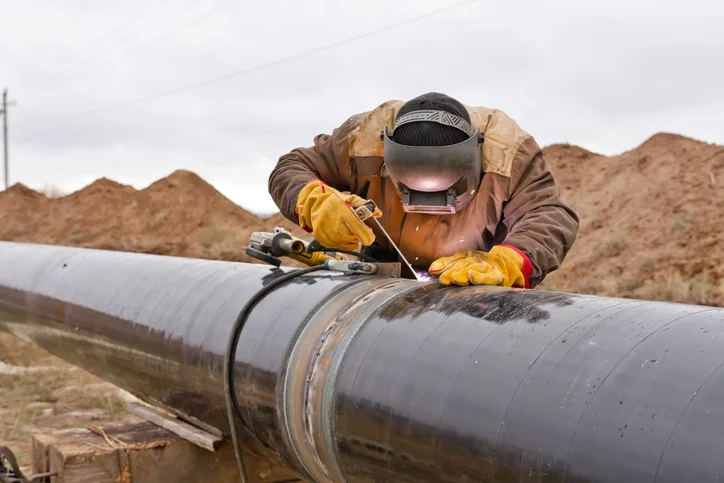Precision Matters: Trusted Pipeline Welding Inspection Solutions for Important Tasks
Precision Matters: Trusted Pipeline Welding Inspection Solutions for Important Tasks
Blog Article
Comprehensive Summary of Pipe Welding Evaluation Treatments
In the world of pipeline construction, making sure the stability and safety and security of welded joints is critical. Pipeline welding evaluation treatments play an essential role in guaranteeing that bonded links fulfill strict industry standards and specifications. From precise pre-welding assessments to comprehensive post-weld evaluations, a well-defined evaluation process is important for maintaining the structural stability of pipelines. Recognizing the details of welding examination treatments is not only a regulatory need however likewise an essential aspect of upholding the integrity of these crucial frameworks.
Pre-welding Inspection Preparations
Prior to beginning the welding procedure, extensive pre-welding assessment preparations are essential to ensure the stability and quality of the weld joint. These prep work include a precise examination of the products to be bonded, the welding devices, and the work environment. By performing complete pre-welding assessment preparations, possible issues can be identified and solved early on, leading to top quality and trustworthy weld joints.
Welding Treatment Certification
Thorough pre-welding inspection prep work lay the foundation for the essential process of Welding Treatment Certification, making sure the stability and top quality of the weld joint. Welding Treatment Qualification (WPQ) is an important action in the welding process that entails testing and licensing welding treatments to guarantee they meet details requirements and needs. The WPQ process commonly includes welding treatment specification growth, welding procedure credentials testing, and paperwork of the outcomes.
Throughout welding procedure requirements growth, essential details such as the welding procedure, welding products, joint design, and welding specifications are specified to create a detailed treatment. Consequently, welding treatment qualification testing is performed to verify the suggested treatment's honesty. This testing commonly entails welding examination discount coupons that undergo various mechanical and non-destructive tests to evaluate the weld's high quality and adherence to the defined criteria.
In-process Weld Evaluation
During the welding procedure, in-process weld assessment plays a crucial function in ensuring the quality and integrity of the weld joint - Pipeline Welding Inspection. This kind of evaluation includes keeping an eye on the welding criteria, analyzing the weld grain development, and detecting any kind of prospective issues or discontinuities as they occur. By conducting in-process weld inspections, welding drivers can promptly address any issues that might emerge, therefore avoiding additional problems and ensuring that the final weld fulfills the called for specs
Typical techniques used for in-process weld inspection include aesthetic examination, liquid penetrant screening, magnetic particle testing, ultrasonic screening, and radiographic testing. Visual evaluation is frequently the first action while doing so, allowing examiners to aesthetically evaluate the weld for surface area irregularities such as cracks, porosity, or insufficient fusion. Advanced approaches like ultrasonic screening and radiographic testing give in-depth insights right into the interior framework of the weld, making sure that there are no covert issues that might endanger the weld joint's toughness and integrity. On the whole, in-process weld examination is crucial for preserving the high quality and reliability of bonded pipelines.
Non-destructive Testing (NDT)
Non-destructive Testing (NDT) is an essential technique used in pipe welding evaluation to examine the honesty of weld joints without triggering damages to the bonded structure. By using different NDT strategies, inspectors can review the quality of welds and recognize any problems or discontinuities that may jeopardize the architectural sturdiness of the pipeline. Common NDT techniques used in pipe welding inspection consist of Radiographic Testing (RT), Ultrasonic Screening (UT), Magnetic Particle Examining (MPT), Fluid Penetrant Testing (LPT), and Visual Screening (VT)
RT involves using X-rays or gamma rays to generate images of the internal structure of the weld, enabling assessors to spot problems such as porosity, fractures, or incomplete fusion. UT utilizes high-frequency acoustic waves to discover defects underneath the surface area of the weld, supplying detailed information concerning the dimension and area of flaws. MPT and LPT are utilized to determine surface-breaking flaws by applying magnetic bits or penetrant liquids to the weld area. In addition, VT includes visual assessment of welds to recognize any type of noticeable flaws.
Post-weld Inspection and Documentation

Documentation of post-weld assessment findings is crucial for preserving quality assurance documents and making sure compliance with sector standards and policies. In-depth reports must include details regarding the assessment techniques made use of, the location and nature of any kind of defects discovered, and any type of rehabilitative actions taken - Pipeline Welding Inspection. Appropriate documents not only functions as a document of the weld's quality yet also aids in future upkeep and inspection procedures
Conclusion

In verdict, pipe welding inspection procedures play an important duty in ensuring the quality and integrity of welds. In general, adherence to appropriate evaluation methods is vital to the success of pipe welding tasks.
From thorough pre-welding examinations to thorough post-weld evaluations, a distinct assessment process is necessary for preserving the structural stability of pipelines. By conducting in-process weld inspections, welding drivers can without delay resolve any kind of problems that may occur, therefore guaranteeing and avoiding further defects that why not find out more the last weld satisfies the required requirements.
Common methods made use of for in-process weld examination include visual examination, liquid penetrant screening, magnetic bit testing, ultrasonic screening, and radiographic testing.Non-destructive Screening (NDT) is an essential method employed in pipe welding evaluation to assess the stability of weld joints without causing damages to the bonded structure. Post-weld examination entails numerous click here for more info methods to analyze the welds for flaws, including aesthetic evaluation, color penetrant testing, magnetic bit screening, ultrasonic testing, and radiographic screening.
Report this page